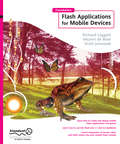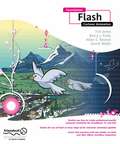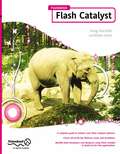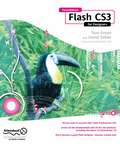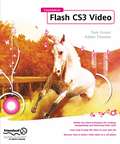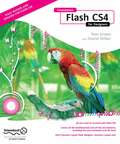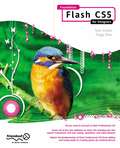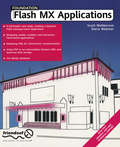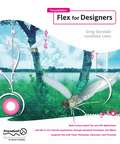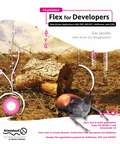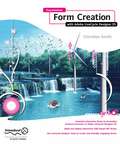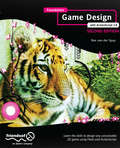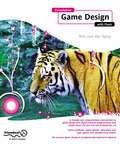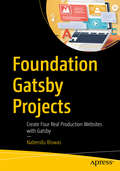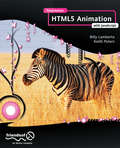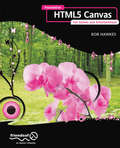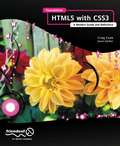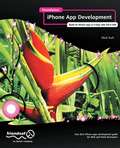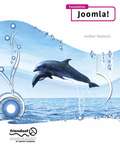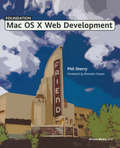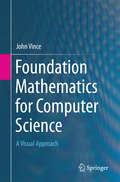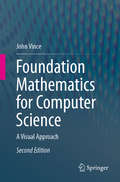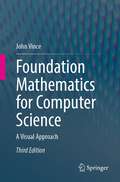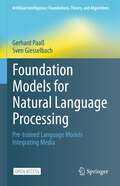- Table View
- List View
Foundation Flash Applications for Mobile Devices
by Richard Leggett Weyert De Boer Scott Janousek* This is the only up-to-date book on the market that covers Flash mobile application development. * Evidence of demand – large companies such as Nokia and Samsung are Flash-enabling their phones. * The book will support the new FlashLite version available with the next version of Flash, released later on this year.
Foundation Flash Cartoon Animation
by Barry Kelly Tim Jones David Wolfe Allan RossonOne of Flash’s most common uses is still animation for cartoons, games, advertising etc, and this book takes a fresh look at the topic, breaking it down pre-production, production, and post production, and looking at each section in detail. It moves on to cover topics such as storyboarding, character libraries and camera mechanics like no book on Flash has done before. It’s been written by members of the Emmy award winning ANIMAX team, who have created work for clients such as Disney, AOL, Fox, WWE, ESPN, and Sesame workshop.
Foundation Flash Catalyst
by Greg Goralski Lordalex LeonThis book offers an introduction to Flash Catalyst for designers with intermediate to advanced skills. It discusses where Catalyst sits within the production process and how it communicates with other programs. It covers all of the features of the Flash Catalyst workspace, teaching you how to create designs from scratch, how to build application designs and add functionality, and how to master the Catalyst/Flex workflow. Introduces Flash Catalyst Focuses on production process Covers the interrelation between Flash Catalyst and Photoshop/Illustrator/Flex/Flash
Foundation Flash CS3 for Designers
by David Stiller Tom GreenThis book is a design-slanted guide aimed at giving aspiring Flash designers a solid grounding in the new version, as well as giving established Flash designers a clear look over the new flash CS3 features. Written by renowned Flash designers Tom Green and David Stiller, it features real world examples throughout, presented in an accessible, friendly tutorial style. No other beginner's Flash CS3 guide is specifically aimed at designers. Flash still remains a huge market area, and in 2007 Adobe released Flash CS3 which boasts a whole host of new features for Flash designers to get excited about.
Foundation Flash CS3 Video
by Adam Thomas Tom GreenFlash is one of the most popular ways in recent years to create interactive video content for the Web. With the new release, Flash CS3, it is set to increase in popularity even more, with more exciting features for developers to use in their applications. This book is an update to the critically-acclaimed Foundation Flash 8 Video, with many new examples added, and code updated to ActionScript 3.0. It provides developers with an essential, accessible guide to getting the most out of their Flash CS3 video applications.
Foundation Flash CS4 for Designers
by Tom Green David StillerIf you're a Flash designer looking for a solid overview of Flash CS4, this book is for you. Through the use of solid and practical exercises, you will soon master the fundamentals of this fourth edition of the Adobe Flash authoring tool. Using a series of carefully developed tutorials, you will be led from basic Flash CS4 techniques to the point where you can create animations, MP3 players, and customized Flash video players in no time. Each chapter focuses on a major aspect of Flash, and then lets you take the reins in a "Your Turn" exercise to create something amazing with what you've learned. This book focuses on the core skill set you need to feel at home with Flash CS4, and also introduces you to some of the biggest names in today's Flash community through interviews and actual "How To" examples, so you can learn from the masters. You will start by studying the Flash CS4 interface, and while you're at it, you'll be guided toward mastery of the fundamentals, such as movie clips, text, and graphics, which will lead you into some of the more fascinating aspects of Flash, including audio, video, animation, and 3D transformations. By the time you finish, you will have created an MP3 player and a Flash video player, been introduced to the basics of ActionScript 3.0, learned how to combine Flash with XML, styled Flash text with CSS, created animated scenes, and worked your way through a host of additional projects. All of these exercises are designed to give you the knowledge necessary to master Flash CS4 from the ground up. If you're already a seasoned Flash designer, this book will get you up to speed with the fourth version in relatively short order. This book covers all of the new Flash CS4 features, such as the new animation and 3D tools, the new Adobe Media Encoder, and a pair of the coolest new additions to the tools panel: a spray brush tool and a deco tool. You can discover more about this book, download source code, and more at the book's companion website: www.foundationflashcs4.com.
Foundation Flash CS5 For Designers
by Tom Green Tiago DiasFlash is one of the most engaging, innovative, and versatile technologies available—allowing the creation of anything from animated banners and simple cartoons to rich Internet applications, interactive videos, and dynamic user interfaces for web sites, kiosks, devices, or DVDs. The possibilities are endless, and now it just got better. Flash CS5 boasts a host of new features, including better support for mobile devices, a whole new animation engine enabling full manipulation of tweens and paths, custom easing, improved inverse kinematics, a revamped timeline, built-in 3D, and much more. This book is all you’ll need to learn Flash CS5 from the ground up. If you already have Flash experience, this book will allow you to quickly catch up on all the cool new features. Flash experts Tom Green and Tiago Dias guide you step-by-step through all facets of Flash CS5, keeping the emphasis firmly on good design techniques that you use in your own projects. Learn Flash design from the ground up, or just get to grips with the new features, with a series of step-by-step tutorials. Provides an easy introduction to ActionScript 3.0 coding, but the focus is mainly kept on design. Learn from the experts—written by renowned Flash designers Tom Green and Tiago Dias.
Foundation Flash MX Applications
by Steve Webster Scott MebbersonThis book provides the richest and most solid introduction to the exciting world of Flash applications, which are becoming increasingly popular as ways of presenting visually rich interfaces to useful data and services. Foundation Flash MX Applications supplies you with the knowledge, techniques, and skills that you need to help you plan, develop, and build Flash-based applications that you can deploy on the Web. In true Foundation series style, this book uses step-by-step exercises and a running case study to build skills that you can then apply to any Flash application you create. The emphasis in this book is on the generic skills and approaches that are essential in this field, rather than on shallow walk-throughs of trivial projects. You'll come away from this book with a deeper understanding of the issues (architectural, technical, process-related, design-oriented) that are key to developing successful Flash applications for the Web. This is the only book on the market that focuses on generic, transferable skills that are taught using a case study that'll really drive the learning home. If you want to really understand this subject, then this is the book for you. To get the most out of this book, we recommend that you already have a grasp of the Flash MX interface, as well as some ActionScript experience. Topics include: A full-length case study, creating a dynamic Flash message board application. Designing usable, scalable, and interactive Flash-based applications. Deploying XML for client/server communication. Using PHP as an intermediary between XML and back-end data storage. The MySQL database.
Foundation Flex for Designers
by Greg Goralski Lordalex LeonThis book details how to customize the look and feel of Flex applications. It takes you through how to customize style and layouts using CSS; how to bring design assets into Flex from applications such as Photoshop, Illustrator, Fireworks, and Flash; how to spice up your design work with some handy ActionScript 3.0 techniques; and even a look forward to designing hybrid desktop/web applications with Flex and AIR. It culminates with several design-oriented case studies, including a video picker application, picture gallery, customer service site, and more.
Foundation Flex for Developers: Data-Driven Applications with PHP, ASP.NET, ColdFusion, and LCDS
by Sas JacobsIn Foundation Flex for Developers, Sas Jacobs explores in detail how to create professional data-centric Flex 2 and Flex 3 applications. In the first half of the book, she starts off with a brief exploration of Flex and ActionScript 3.0, before looking at application essentials in detail, including creating custom components, user and web browser interactions, binding, formatting and validating data, debugging, and more. The second half of the book focuses on connecting Flex to data sources and covers XML, Flex Data Services, PHP, ASP.NET, and ColdFusion in detail, via a series of step-by-step case studies.
Foundation Form Creation with Adobe LiveCycle Designer ES
by Roderick SmithForm creation is key to information processing and forms workflow is a key concept within Adobe LiveCycle Enterprise Suite. Adobe LiveCycle Forms ES is a stand-alone product that also comes bundled with Adobe LiveCycle Enterprise Suite. This is the first and only book about this new product specifically created for the design, creation, and processing of dynamically interactive forms. Foundation Form Creation with Adobe LiveCycle Designer ES is written for users of all abilities, with introductory material for beginners and advanced techniques for more experienced users. It discusses both the best-practices of designing forms that work and the specifics of implementing them efficiently for data collection—the full life cycle of working with forms. Adobe LiveCycle is all about creating efficient workflows for processing information, and this book demonstrates the full power of the various workflows available for collecting data using one of the most ubiquitous tools available—forms. Complete and thorough coverage of Adobe LiveCycle Designer ES Workflows for the design, implementation, and processing of forms Create and deploy interactive XML-based forms as HTML, PDF, or SWF Integrate forms with third-party tools
Foundation Game Design with ActionScript 3.0
by Rex van der SpuyIn response to the success of the first edition of Foundation Game Design with Flash, Rex van der Spuy has revised and updated all the code to meet current programming best practices, and the focus is now on accurate ActionScript 3.0, regardless of the IDE that you use. We’ve all sneaked the odd five minutes here or there playing the latest Flash game that someone sent around the office, but creating those games is trickier than it looks. The aim of Foundation Game Design with ActionScript 3.0 is to take you, even if you’ve minimal multimedia or programming experience, through a series of step-by-step examples and detailed case studies—to the point where you'll have the skills to independently design any conceivable 2D game using Flash and ActionScript. Foundation Game Design with ActionScript 3.0 is a non-technical one-stop shop for all the most important skills and techniques a beginning game designer needs to build games with Flash from scratch. Whether you're creating quick blasts of viral amusement, or more in-depth action or adventure titles, this is the book for you. Focused and friendly introduction to designing games with Flash and ActionScript Detailed case studies of Flash games Essential techniques for building games, with each chapter gently building on the skills of preceding chapters Modern best practices and new content on ActionScript 3.0 Also covers asset creation in Photoshop and Illustrator
Foundation Game Design with Flash
by Rex van der SpuyWe've all sneaked the odd five minutes here or there playing the latest Flash game that someone sent round the office, but creating those games is trickier than it looks. The aim of Foundation Game Design with Flash is to take you, even if you've minimal multimedia or programming experience, through a series of step-by-step examples and detailed case studies to the point where you'll have the skills to independently design any conceivable 2D game using Flash and ActionScript. The book is a non-technical one-stop-shop for all the most important skills and techniques a beginner game designer needs to build games with Flash from scratch. Whether you're creating quick blasts of viral amusement, or more in-depth action or adventure titles, this book is for you. Focused and friendly introduction to designing games with Flash and ActionScript Five detailed case studies of Flash games Essential techniques for building games, with each chapter gently building on the skills of preceding chapters
Foundation Game Design with HTML5 and JavaScript
by Rex van der SpuyFoundation Game Design with HTML5 and JavaScript teaches you everything you need to know about how to make video games. If you’ve never done any programming before and don’t know where to start, this book will show you how to make games from start to finish. You’ll learn all the latest programming technologies (HTML5, CSS, and JavaScript) to create your games. All written in a fun and friendly style with open-ended projects that encourage you to build your own original games.Foundation Game Design with HTML5 and JavaScript starts by showing you how you can use basic programing to create logic games, adventure games, and create interactive game graphics. Design a game character, learn to control it with the keyboard, mouse, or touch screen interface, and then learn how to use collision detection to build an interactive game world. You’ll learn to make maze games, platform jumping games, and fast paced action games that cover all the popular genres of 2D gaming. Create intelligent enemies, use realistic physics, sound effects and music, and learn how to animate game characters. Whether you're creating games for the web or mobile devices, everything you need to get started on a career as a game designer is right here. Focused and friendly introduction to making games with HTML5. Essential programming and graphic design techniques for building games, with each chapter gently building on the skills of preceding chapters. Detailed case studies demonstrating techniques that can be used for making games in a wide variety of genres.
Foundation Gatsby Projects: Create Four Real Production Websites with Gatsby
by Nabendu BiswasEnhance your Gatsby skillset by building a series of ready-to-use web sites. With the aid of four projects, this book teaches you how to use Gatsby alongside the latest technologies, including Contentful, Twillio, and Stackbit. In the first project, you will create a simple agency site with a contact form and deploy it to Netlify. You'll then quickly be able to create other basic client sites. Next, you will learn to set up a blog site using Stackbit and Dev CMS. Other projects include a large site built with Contentful and a video chat using Twilio. Many Gatsby tutorials out there today only cover how to create blog sites – get ahead of the crowd using this book today. What You'll Learn Use Contentful CMS with GatsbyBuild sites quickly with Stackbit serviceDevelop a video chat site similar to Skype with Twilio services Deploy all sites in NetlifyAdd functionalities with the powerful Gatsby plugin ecosystem Integrate advertisements Who This Book Is For Anyone who wants to create a site using Gatsby. A little knowledge of React is expected but is not a necessity. You will need to be familiar with JavaScript concepts and be confident with basic web development.
Foundation HTML5 Animation with JavaScript
by Billy Lamberta Keith PetersFoundation HTML5 Animation with JavaScript covers everything that you need to know to create dynamic scripted animation using the HTML5 canvas. It provides information on all the relevant math you'll need, before moving on to physics concepts like acceleration, velocity, easing, springs, collision detection, conservation of momentum, 3D, and forward and inverse kinematics. Foundation HTML5 Animation with JavaScript is a fantastic resource for all web developers working in HTML5 or switching over from Flash to create standards-compliant games, applications, and animations that will work across all modern browsers and most mobile devices, including iPhones, iPads, and Android devices. You will learn how to utilize the amazing animation and physics-based code originally created by author Keith Peters in his hugely successful Foundation ActionScript Animation in all of your HTML5 applications. In no time at all, you'll understand the concepts behind scripted animation and also have the ability to create all manner of exciting animations and games.
Foundation HTML5 Canvas: For Games and Entertainment
by Rob HawkesFoundation HTML5 Canvas: For Games and Entertainment teaches you how to make exciting interactive games and applications using HTML5 canvas. Canvas lets you produce graphics, animations, and applications using the HTML5 and JavaScript web standards. It allows you to draw directly within the browser without the need for third-party plugins like Adobe Flash, and so canvas works perfectly across desktop and mobile devices, like the iPhone and Android. Foundation HTML5 Canvas begins by introducing you to HTML5 and the cool new features that it opens up for you. You are then offered a quick guide to JavaScript programming to get you up to speed. Next up you'll receive a thorough introduction to the canvas element, which teaches you how to draw objects within the browser with great ease. Once the basics are covered you’ll move on to the more advanced features of canvas, including image and video manipulation. You’ll also learn how to create realistic animations with the help of some basic physics. Foundation HTML5 Canvas then teaches you how to create two thrilling space-based games using all the skills you’ve learned so far. You'll find plenty of code examples and illustrations designed to help you understand even the most complex of topics. HTML5 is already here for you, and this book will provide you with all the information you need to enjoy the show. For more information, source code, and the latest blog posts from author Rob Hawkes, visit http://rawkes.com/foundationcanvas.
Foundation HTML5 with CSS3
by Craig Cook Jason GarberIf you want to get into developing web sites, the most important thing you'll need is a solid understanding of Hypertext Markup Language, or HTML—the most common language used to write web site content. The most recent version of the language is HTML5, and it contains a whole host of new features to give you more power when creating websites. Foundation HTML5 with CSS3: A Modern Guide and Reference incorporates practical examples to show how to structure data correctly using HTML5, along with styling and layout basics using the latest release of Cascading Style Sheets, CSS3. This book is forward-thinking because all the featured code and techniques are standards-compliant, and it demonstrate best practices—you won't waste your time on outdated, bad techniques. Your web pages will work properly in most web browsers and be accessible to web users with disabilities, easily located using popular search engines, and compact in file size. Even if you already know HTML5 and CSS3 basics, this book will still be useful to you. It features comprehensive reference tables, so you can look up troublesome attributes, codes, and properties quickly and easily.
Foundation iPhone App Development: Build An iPhone App in 5 Days with iOS 6 SDK
by Nick KuhTaking a hands-on learning approach, Foundation iPhone App Development: Build An iPhone App in 5 Days with iOS 6 SDK quickly enables existing programmers to become familiar and comfortable coding Objective-C using Xcode 4.5, Storyboarding and the iOS 6 SDK to create apps for the iPhone. Nick Kuh, an experienced, Apple award-winning developer, will teach readers how to build an iOS 6 iPhone app from start to finish in 5 days. During a 5-day process you will learn how to build a professional, custom-designed, object-oriented iPhone App. You’ll start with a PhotoShop PSD design and an app idea. Then, throughout the remainder of the book, Nick will guide you through each stage of building the app. But it’s you who will build the app. You will learn how to think like an app developer, how to turn an idea into a beautiful iPhone app. In addition to the code and programming practices introduced, the book includes numerous tips, tricks and lessons learned to help new iPhone App developers succeed on the App Store: SEO, in-app marketing approaches and how to win more 5 star reviews. The 5-day learning process is divided into the following key stages: Day 1 begins with the initial planning, paper prototyping and Photoshop design phases of an app idea. You’ll learn how to provision your iOS apps for deployment to your iPhone. By the end of your first day you’ll get to learn on the job, creating an Object-Oriented Black Jack Game that implements the Model View Controller paradigm in Objective C. Day 2 is all about Storyboarding: creating and connecting all of the user interface views of our app. Day 3 begins with table views and data population. By the end of the third day you’ll be knee-deep in Core Data: building a data model and creating an editable, persistent data storage solution for your app. By Day 4 you’ll be learning how to communicate with Facebook using Apple’s new Social framework introduced in iOS 6. Day 5 kicks off with code and methods to add in-app social network marketing to your app. With your completed app you’ll then learn how to submit an App to Apple alongside numerous tips and tricks to improve your chances of success and visibility in this unique marketplace. From start to finish, this book inherits Nick’s tried and tested methods to build beautiful native iPhone Apps efficiently. After reading and using this book, you’ll come away with a core iOS development process and coding concepts that can be re-used and applied to your own iPhone app projects. Moreover, you’ll gain an understanding of how to architect your own apps, write reusable code and implement best practices for faster productivity and maybe even make some money, too.
Foundation Joomla!
by Bintu HarwaniDo you want the ability to manage documents, photos, and other content over the Web but don't want to shell out thousands of dollars in proprietary solutions? Want to create an online community for your hobby or user group? You're not alone. For thousands of like-minded around the globe, the answer is Joomla!, an open-source content management system (CMS) used to manage all sorts of data over the Web. While Joomla! is relatively easy to install, a fair amount of knowledge is required in order to configure the application to your specific needs. Foundation Joomla! is an entry developer and user's guide that gets you started with this popular CMS in little or no time.
Foundation Mac OS X Web Development
by Phil Sherry* This book is unique in its stance of the Mac as a platform for web development. Mac OS books are either low-level Dummies/VQS-style references on using the interface or the entirely separate market of writing software and applications for the Mac OS. This book is ideally placed to appeal to tap into the merging job role of the web developer/designer.
Foundation Mathematics for Computer Science: A Visual Approach
by John VinceJohn Vince describes a range of mathematical topics to provide a foundation for an undergraduate course in computer science, starting with a review of number systems and their relevance to digital computers, and finishing with differential and integral calculus. Readers will find that the author's visual approach will greatly improve their understanding as to why certain mathematical structures exist, together with how they are used in real-world applications.Each chapter includes full-colour illustrations to clarify the mathematical descriptions, and in some cases, equations are also coloured to reveal vital algebraic patterns. The numerous worked examples will consolidate comprehension of abstract mathematical concepts.Foundation Mathematics for Computer Science covers number systems, algebra, logic, trigonometry, coordinate systems, determinants, vectors, matrices, geometric matrix transforms, differential and integral calculus, and reveals the names of the mathematicians behind such inventions. During this journey, John Vince touches upon more esoteric topics such as quaternions, octonions, Grassmann algebra, Barycentric coordinates, transfinite sets and prime numbers. Whether you intend to pursue a career in programming, scientific visualisation, systems design, or real-time computing, you should find the author’s literary style refreshingly lucid and engaging, and prepare you for more advanced texts.
Foundation Mathematics for Computer Science: A Visual Approach
by John VinceIn this second edition of Foundation Mathematics for Computer Science, John Vince has reviewed and edited the original book and written new chapters on combinatorics, probability, modular arithmetic and complex numbers. These subjects complement the existing chapters on number systems, algebra, logic, trigonometry, coordinate systems, determinants, vectors, matrices, geometric matrix transforms, differential and integral calculus. During this journey, the author touches upon more esoteric topics such as quaternions, octonions, Grassmann algebra, Barrycentric coordinates, transfinite sets and prime numbers. John Vince describes a range of mathematical topics to provide a solid foundation for an undergraduate course in computer science, starting with a review of number systems and their relevance to digital computers, and finishing with differential and integral calculus. Readers will find that the author’s visual approach will greatly improve their understanding as to why certain mathematical structures exist, together with how they are used in real-world applications. This second edition includes new, full-colour illustrations to clarify the mathematical descriptions, and in some cases, equations are also coloured to reveal vital algebraic patterns. The numerous worked examples will help consolidate the understanding of abstract mathematical concepts. Whether you intend to pursue a career in programming, scientific visualisation, artificial intelligence, systems design, or real-time computing, you should find the author’s literary style refreshingly lucid and engaging, and prepare you for more advanced texts.
Foundation Mathematics for Computer Science: A Visual Approach
by John VinceIn this third edition of Foundation Mathematics for Computer Science, John Vince has reviewed and edited the second edition, and added chapters on systems of counting, area and volume. These subjects complement the existing chapters on visual mathematics, numbers, algebra, logic, combinatorics, probability, modular arithmetic, trigonometry, coordinate systems, determinants, vectors, complex numbers, matrices, geometric matrix transforms, differential and integral calculus. During this journey, the author touches upon more esoteric topics such as quaternions, octonions, Grassmann algebra, Barrycentric coordinates, transfinite sets and prime numbers.John Vince describes a range of mathematical topics that provide a solid foundation for an undergraduate course in computer science, starting with a review of number systems and their relevance to digital computers, and finishing with calculating area and volume using calculus. Readers will find that the author’s visual approach should greatly improve their understanding as to why certain mathematical structures exist, together with how they are used in real-world applications.This third edition includes new, full-colour illustrations to clarify the mathematical descriptions, and in some cases, equations are also coloured to reveal vital algebraic patterns. The numerous worked examples will help consolidate the understanding of abstract mathematical concepts.Whether you intend to pursue a career in programming, scientific visualisation, artificial intelligence, systems design, or real-time computing, you should find the author’s literary style refreshingly lucid and engaging, and prepare you for more advanced texts.
Foundation Models for Natural Language Processing: Pre-trained Language Models Integrating Media (Artificial Intelligence: Foundations, Theory, and Algorithms)
by Gerhard Paaß Sven GiesselbachThis open access book provides a comprehensive overview of the state of the art in research and applications of Foundation Models and is intended for readers familiar with basic Natural Language Processing (NLP) concepts. Over the recent years, a revolutionary new paradigm has been developed for training models for NLP. These models are first pre-trained on large collections of text documents to acquire general syntactic knowledge and semantic information. Then, they are fine-tuned for specific tasks, which they can often solve with superhuman accuracy. When the models are large enough, they can be instructed by prompts to solve new tasks without any fine-tuning. Moreover, they can be applied to a wide range of different media and problem domains, ranging from image and video processing to robot control learning. Because they provide a blueprint for solving many tasks in artificial intelligence, they have been called Foundation Models. After a brief introduction to basic NLP models the main pre-trained language models BERT, GPT and sequence-to-sequence transformer are described, as well as the concepts of self-attention and context-sensitive embedding. Then, different approaches to improving these models are discussed, such as expanding the pre-training criteria, increasing the length of input texts, or including extra knowledge. An overview of the best-performing models for about twenty application areas is then presented, e.g., question answering, translation, story generation, dialog systems, generating images from text, etc. For each application area, the strengths and weaknesses of current models are discussed, and an outlook on further developments is given. In addition, links are provided to freely available program code. A concluding chapter summarizes the economic opportunities, mitigation of risks, and potential developments of AI.
